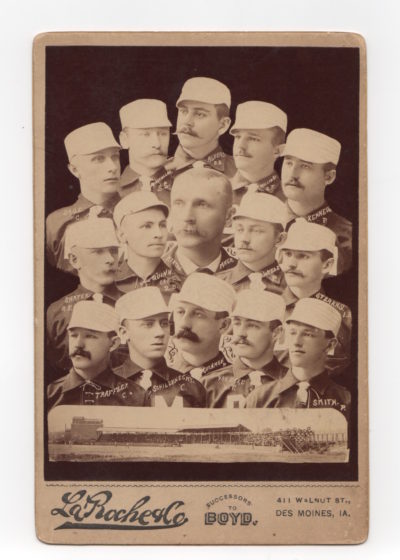Special series scores the game, 1858-1875
Professional baseball: The Des Moines and Sioux City ‘Welcome’

An 1889 CdV (Carte-de-Visite) shows the Des Moines Prohibitionists of the Western Association. Unfortunately, their 41-77 season record led to a last-place finish. Pictured also is Des Moines’ first professional ballpark — Athletic Park, located at Southwest 7th Street (and the Raccoon River).
By John Liepa
By the mid-1880s, baseball was being played everywhere in Iowa. In bigger cities and small towns, it was a point of community pride to field one or more teams. Tournaments were played regularly to determine the “state champions” each year. The rules that had become the accepted norm were the National Association of Professional Base Ball Players (NAPBBP) 1871 rules. Equipment had evolved and now gloves, catcher’s masks and standardized balls and bats were available through sporting goods companies such as Spalding or Peck & Snyder.
Up to this time in Iowa history, the games and players were almost entirely amateur — with a few notable exceptions — the atmosphere at games was competitive, but casual; the playing fields and ballparks varied tremendously; admission to games was minimal and not strictly enforced; and the life-spans of teams and clubs lasted sometimes from a few games to a number of seasons. The few exceptions to the amateur game were: Keokuk’s 1875 fielding of Iowa’s first all-professional baseball team, joining the National Association — considered America’s first major league — and abruptly ending as a failure after 13 games; Dubuque’s “shortened” 1879 season as part of the Northwestern League; and a second attempt by Keokuk in 1885, as part of the Western League, with neither the team or league surviving the season.
Although Des Moines had not attempted to field a all-professional team by 1886, it already had played the game for 20 years. As Des Moines entered the mid-1880s, it was of mixed opinion whether or not to field an all-professional baseball team. Interestingly, the division was along lines of social class. In the spring of 1885, the Saturday Evening Mail, a weekly newspaper patronizing to a large extent the city’s elite, declared, “the national game, baseball is at a low ebb.” Nearly a year later, the Des Moines Daily News, a working class paper reported: “Never before was there so much interest in baseball as there is this season.” So who was right?
TO READ MORE ABOUT THIS STORY AND OTHER FASCINATING STORIES ABOUT IOWA HISTORY, subscribe to Iowa History Journal. You can also purchase back issues at the store.
